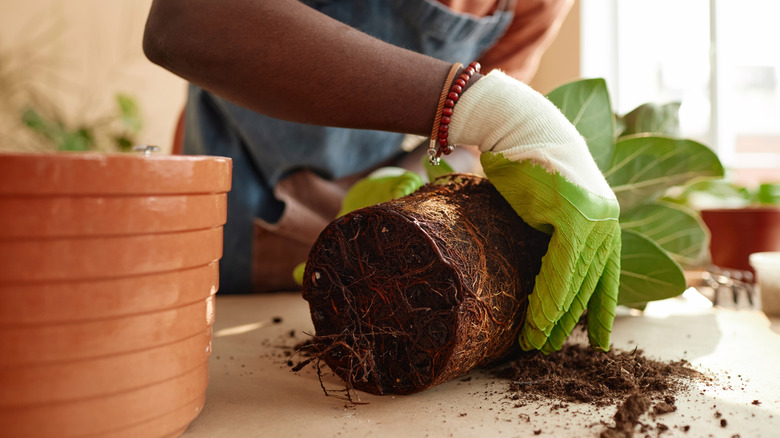What To Do In October To Keep Houseplants Happy All Winter Long
If your home has central air and heat, the temperature is likely pretty regular all year long. A little warmer in summer and a bit cooler in winter, it's easy to think of our living spaces as a seasonless bubble that allows our houseplants to live without natural cycles. Nevertheless, your indoor garden still experiences a winter slowdown in growth. If you have any potted friends who could use upgraded digs, October is your last chance to make this happen before the plants take a break from growing.
In general, the best time to repot houseplants is in the spring or summer, but if you have one or more that are rootbound, a fall pot swap will give your plants' roots some legroom to spread out for a comfy, happy hibernation. While it's not technically "hibernation", most plants enter dormancy in the winter in response to cooler temperatures and lower light levels. Some experts even prefer repotting plants in the fall, since they believe slowed growth can make the plants less susceptible to shock as they settle into a new pot and soil.
Take a quick stock of your indoor growing things. If you can't remember the last time you repotted them, these guys could be top candidates for a pot refresher. Repotting your houseplants once a year is a good practice. However, to eliminate unnecessary stress on the plants, limit your subjects to those that are really begging for a new pot.
Steps to repotting plants in fall
Are there roots growing through the drainage holes? Does the soil not maintain moisture well? And most importantly, has the plant not been growing as much as you'd expect? These are indicators that your plant has outgrown its space. Find a pot with good drainage that's 1 to 2 inches wider than the plant's current pot. When you're repotting plants, fresh growing medium is just as important as sizing up the pot to accommodate next season's growth. There are plenty of reasons why you should change your indoor plants' soil, including depleted nutrients, compaction, and salt buildup from fertilizers.
Do as much as you can to reduce transplant shock when repotting your houseplants. A few hours before handling the plant, give it a bit of water to help it slide out of its old pot more easily. Take great care with the root ball; very gently separate tangled or bound roots, and trim away any dead ones before replanting. Partially fill the pot with new soil, set the roots on top, and surround them with more new soil. Give the plant a healthy drink, but don't fertilize it at this time. In its new home, your plant will prefer not to have soggy soil, and in general, houseplants need less water in the winter. You may want to do a quick internet search to see how much water your particular plants will need while they're dormant.

